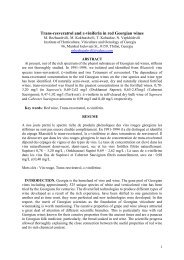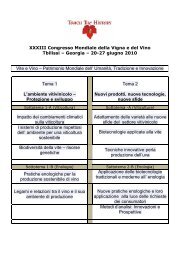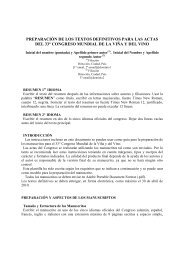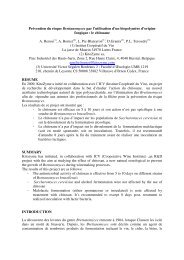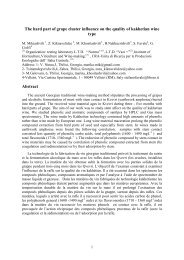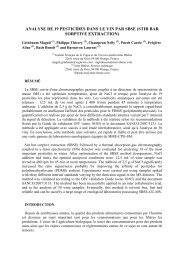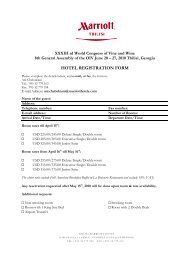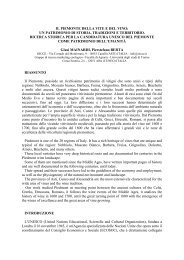exact management of dissolved gases of wines by ... - Oiv2010.ge
exact management of dissolved gases of wines by ... - Oiv2010.ge
exact management of dissolved gases of wines by ... - Oiv2010.ge
You also want an ePaper? Increase the reach of your titles
YUMPU automatically turns print PDFs into web optimized ePapers that Google loves.
GC analyses <strong>of</strong> higher alcohols and esters <strong>of</strong> wine showed that only some esters underwent<br />
significant losses being able to go up to 40%, especially ethyl-octanoate, ethyl-hexanoate,<br />
isoamyl-acetate and hexyl-acetate, which are the most hydrophobic molecules, which thus<br />
have most affinity for the membrane passage according to Diban et etc., 2008.<br />
Comparatively, deoxygenation <strong>of</strong> the <strong>wines</strong> <strong>by</strong> nitrogen sparging with porous diffuser<br />
causes important losses for the same molecules because <strong>of</strong> their volatility.<br />
Sensory analysis <strong>by</strong> triangular test<br />
A white and a red wine with respective O 2 initial contents <strong>of</strong> 0.79 and 0.82 mg/L and CO 2<br />
initial content <strong>of</strong> 620 and 260 mg/L were deoxygenized <strong>by</strong> sparger and with WineBrane ® <strong>by</strong><br />
strip and combo modes (T° <strong>wines</strong> = 23 ± 1°C). The final average O 2 contents were<br />
respectively <strong>of</strong> 0.20 (white) and 0.14 mg/L (red) and for CO 2 <strong>of</strong> 669 ± 68 (white) and 255 ±<br />
36 mg/L (red). 15 days after, a triangular test was carried out <strong>by</strong> 19 tasters in order to compare<br />
the wine before and after the deoxygenation for each wine and each treatment. No significant<br />
difference was revealed to the α risk <strong>of</strong> 5%, in spite <strong>of</strong> the ester losses quoted previously.<br />
Only the <strong>wines</strong> deoxygenized <strong>by</strong> sparger (porous diffuser) were considered to be different<br />
from the control <strong>wines</strong> to the α risk = 14.6% (white) and 6.5% (red).<br />
CONCLUSIONS<br />
The <strong>dissolved</strong> gas <strong>management</strong> <strong>by</strong> membrane contactor constitutes a real progress during<br />
the phase for conditioning <strong>of</strong> <strong>wines</strong>. A full automatic WineBrane ® unit integrated in a bottling<br />
line (like at the wine coop <strong>of</strong> Besigheim) or in a bag in box line enables the simultaneous<br />
control and adjustment <strong>of</strong> the two most important <strong>dissolved</strong> <strong>gases</strong> in oenology: the oxygen<br />
major factor <strong>of</strong> the <strong>wines</strong> oxidation and the carbonic gas major factor <strong>of</strong> the sensory quality <strong>of</strong><br />
<strong>wines</strong>. Currently no competitive technology is available which is able to meet these needs<br />
accurately and simultaneously in line.<br />
The first tests showed that the main analytical parameters (alcohol, acidities and colour) are<br />
not affected <strong>by</strong> the treatment. Only losses in some esters were observed without impact on the<br />
tasting <strong>of</strong> the wine.<br />
Further studies starting this year will focus on gaseous exchange and on the behaviour <strong>of</strong><br />
polyphenols. For that, other operating conditions like temperature variation, different gas<br />
concentrations, wine types, inert gas consumptions … will be verified.<br />
ACKNOWLEDGEMENT<br />
The authors thank Magaly Angénieux from INRA 999UE Pech-Rouge for the GC analysis<br />
<strong>of</strong> volatile compounds and the INOXPA Company for the provision <strong>of</strong> the WineBrane pilot<br />
unit.<br />
BIBLIOGRAPHY<br />
Berta P., Spertino M., Vallini E., 2000. Controllo dell’ossigeno durante l’imbottigliamento<br />
di vini frizzanti e spumanti. Industrie delle Bevande, 2000, XXIX dicembre, 618-622.<br />
Boulet J.C., Vidal J.C., 1999. Dissolution d’oxygène à la mise en bouteille. Compte rendu<br />
d’expérimentation INRA UE PR Gruissan.<br />
Castellari M., Simonato B., Torinielli G.B., Spinelli P., Ferrarini R, 2004. Effects <strong>of</strong><br />
different enological treatments on <strong>dissolved</strong> oxygen in <strong>wines</strong>. Ital. J. Food Sci., vol16,nº3,<br />
387-396.



